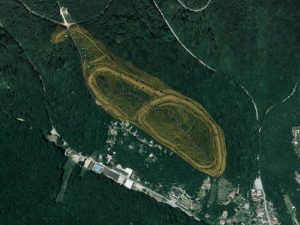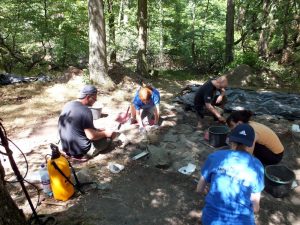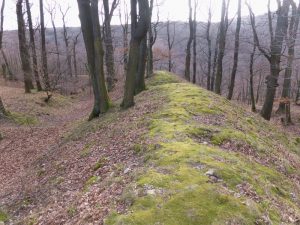The site of a Medieval fortress in Svätý Jur, outside Bratislava, Slovakia, was researched by archaeologists who uncovered artefacts of one of the most important Slavic castles in the region.

The site with the remains of the earthworks is situated on the mountain ridge of the Little Carpathians above Svätý Jur, at a height of 342 meters above sea level. Archaeologists believe that the fortress served a military-strategic function in 8th century. Artefacts from the 9th to 10th century indicate that the fort was an important military refuge, but we also know that it was a manufacturing centre and a very populated place. Archaeologists suppose that the castle and two other forts on the other side of the Little Carpathians – sat on the borders between the joined principalities Nitra and Moravia of the Great Moravian Empire.

The ruins of the former fortress are in the woody outcrop above the cottage area. They are identified by mighty, still preserved mounds of the elliptical acropolis and two younger horseshoe-like lower fortifications connected to the acropolis from the northwest. On the two sides of the valleys under the fort are two tributaries of Starý Potok river. The length of the fort, including both wards, is about 680 meters. The area of the fort is about 8.5 ha. Experts state that the castle of Svätý Jur supplied castles in Bratislava and Devín with products and military support. It could have also been a possible refugium at the rear. The fort in Svätý Jur was probably one of the most important castle in the region, just after Preslava and Dovina, although each castle had its own function.

The defence system was formed gradually.Archaeologists believed that the predecessor of the massive wall of the acropolis had been built by the second half of the 8th century. The bulwark of the acropolis was later reinforced with a wooden slatted construction, which was protected from the front by a stone parapet. The thickness of the biggest walls was at least 4.5 meters. The height of the wall might have been the same as its thickness. The walls of the acropolis and the first ward were lined from the inside and outside by moats, and both parts of the fort were protected in the more accessible northwest part by additional walls and moats.

Among the finds made over the years at the hillfort is a deposit which included jewellery (earrings, a knob pendant and a ring), a knife, a spear and a vessel. Another significant discovery was of a quadratic building on stone foundations from the Great Moravian period, which has few comparisons. An Arabic coin from the Abbasid caliphate, or Arab Empire was also found. It dates to 867 and was emitted by Caliph Al-Mu´tazz. It is the first Arabic silver coin found in Great Moravia. Other coins found at the fortress include Roman, one Celtic coin and specimen from the 17th century. Archaeologists also managed to document a place where jewellery may have been produced. Interesting find, attesting to trade links of the site is a glass whorl, similar to one found in the territory of the Frankish Empire, dating from the 6th and 7th century and the times of the Merovingian dynasty. Moreover numerous finds of iron products, coloured metal, and ceramics were also made at the site.

(after The Slovak Spectator, Archive of Malokarpatské Múzeum in Pezinok & Malokarpatské Múzeum in Pezinok)